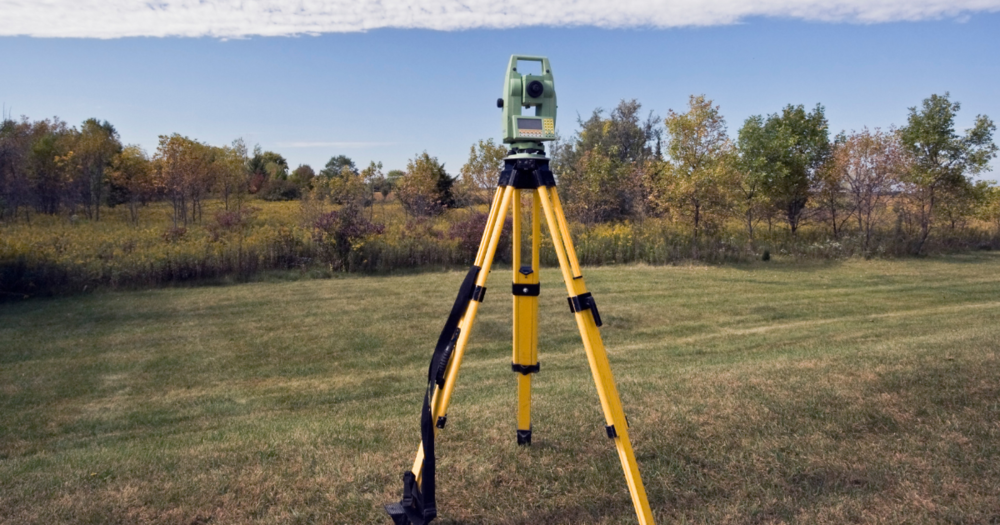
Your total station is one of the most important – and expensive – tools on the job site. Whether you're doing construction layout, land surveys, or geospatial mapping, keeping that equipment in top shape matters.
Daily Total Station Care
A few quick steps each day will help you avoid expensive repairs and extend the life of your equipment.
Store and Transport It the Right Way
- Always use the padded case. Total stations are precise instruments, and even small bumps during transport can knock things out of alignment.
- Protect it from shock. If you’re moving gear over rough terrain, add foam padding or use a shock-absorbing pack.
- Keep it covered. When not in use, use a hard shell case or a weather-resistant cover to protect against rain, dust, and direct sun.
Wipe It Down After Every Use
- Clean lenses gently. Use a microfiber cloth to wipe away dust, smudges, or water spots. Avoid paper towels since they can scratch the lens.
- Dry the body. If your total station was rained on or used in humid weather, dry it off before storing it. If left too long, moisture will creep into joints and screens.
- Don’t forget connectors. Dust and grit in ports or threads will cause problems later. Give those areas a quick check before packing up.
Keep It Out of Harsh Weather
- Don’t leave it in a hot truck. High heat will warp plastic parts and mess with internal sensors.
- Avoid freezing temps. Cold weather will cause parts to contract and batteries to lose power fast.
- Limit UV exposure. Use a sunshade or cover between uses if you’re in bright sun all day. UV rays will damage screens, plastic housings, and rubber seals over time.
Schedule Maintenance and Equipment Calibration
Daily care keeps your total station running smoothly, but long-term reliability depends on regular maintenance and calibration. These aren't just “nice to have” extras. They’re essential if you want your equipment to stay accurate and ready for every job.
Stick to the Calibration Schedule
- Follow the manual. Every total station model comes with a manufacturer-recommended calibration timeline. It's usually once a year, or more often if you're using it daily or in tough conditions.
- Don’t wait for problems. If your data seems off or you notice odd behavior, get it checked. Catching calibration drift early keeps your results accurate and avoids rework.
Use Certified Pros
- Find an authorized service center. Professional calibration shops have the right tools and knowledge to handle complex adjustments. Many manufacturers (like Trimble, Sokkia, and Leica) provide recommendations for total station technicians.
- Check credentials. Not all calibration services are equal. Make sure they use traceable standards and can provide documentation of the work done.
Know What Needs Checking
Some internal parts can slip out of alignment over time, especially with regular use or rough handling. Pay attention to:
- Collimation: This ensures that the line of sight is properly aligned. If it’s off, your angle measurements will be off, too.
- Tilt sensors: These help level your instrument. Even small shifts here will throw off vertical readings.
- Angle encoders: These are the digital brains behind your horizontal and vertical angle tracking. Dirty, worn, or misaligned encoders can cause serious data errors.
If you're not sure how often to check these, schedule an inspection during your annual service or if you notice strange readings.
Read
How to Calibrate Your Land Surveying Equipment for more information.
Keep a Maintenance Log
- Track service dates and write down every calibration, repair, and battery swap. This will help you stay ahead of issues and keep your equipment in warranty.
- Log issues. If you’ve had problems with connectivity, battery life, or lens fogging, note them down. Over time, patterns can point to a bigger issue.
- Boost resale value. A clean maintenance history shows buyers your total station has been well cared for. It also helps justify a higher resale price.

Battery Care and Charging Best Practices
Your total station is only as reliable as its power source. Poor battery habits lead to short runtimes, failed starts, or even long-term damage to your equipment. A few simple charging and storage practices will keep your batteries running longer.
Use the Right Charger
- Stick with OEM chargers. Chargers made by the manufacturer are built to match your battery’s voltage and charging profile. Off-brand options can overheat batteries or shorten their life.
- Avoid fast chargers (unless recommended). They may speed things up, but the extra heat will wear down the battery faster.
Don’t Let Batteries Run Empty
- Avoid deep discharges. Do not drain your batteries to 0%. This puts stress on the cells and reduces overall capacity.
- Recharge at 20–30%. This keeps the battery healthier over time and helps avoid unexpected power loss in the middle of a job.
Store Batteries Smart
- Keep them at partial charge. If you’re not using your batteries for a while, store them around 50% full, not fully charged or completely drained.
- Watch the temperature. Avoid storing batteries in hot trucks or freezing sheds. Aim for a cool, dry place between 50–70°F.
Replace Before They Fail
- Track battery age. Most survey-grade batteries last 2–3 years with regular use. Don’t wait for them to die unexpectedly. Replace them once you notice shorter runtimes or inconsistent performance.
- Label your batteries. Mark the date when each battery was first used so you can rotate and replace them on schedule.
Protecting Your Investment in the Field
Field conditions aren’t always ideal, but good habits will keep your total station safe in harsh environments.
Set It Up Right
- Use a solid tripod. Choose one with good vibration resistance and stable legs, especially on uneven ground. Wobbly setups lead to poor measurements and extra wear on the tilt sensors and motors.
- Level carefully. A quick check with a bubble or digital level ensures proper setup. Starting off unbalanced forces the instrument to compensate, which adds strain over time.
Secure Accessories and Cables
- Wrap cables neatly. Dangling or tangled cables wear out faster and are more likely to get caught or pinched.
- Use strain reliefs. For devices that plug in, secure the cable to the tripod or control handle so it doesn’t pull directly on the port.
Watch Where You Work
- Avoid rough terrain when possible. Constant vibration from loose gravel or wind-swaying tripods will throw off readings and wear out moving parts.
- Use proper base plates or platforms. A leveling base or tripod mat can keep your setup firm on unstable surfaces like sand or wet soil.
Shield It from the Elements
- Use a cover between uses. Whether it's a hood, sunshade, or rain guard, keeping your total station covered when idle blocks out moisture, UV rays, and dust.
- Don’t leave it out. Even if you're just stepping away for a few moments, pack it up or cover it, especially in direct sunlight or light rain.
- Wipe down after exposure. If dust or water hits the unit, clean it right away before it dries and settles into ports or joints.
Protect Your Investment, One Step at a Time
When routine care and proactive maintenance become part of your workflow, you’ll see the payoff in fewer repairs, longer equipment life, and better ROI.
Keep your total station accurate and reliable. Learn daily care tips, battery best practices, and when to calibrate to extend the life of your equipment.